You won’t find any amusement parks at Lake Ohrid, Macedonia. Nor will you find a wild party scene. You can windsurf on the lake, but this isn’t the adventure capital of the world, either. There are no aggressive in-your-face touts littering the town’s main square and even the handful of vendors selling Ohrid’s famous pearls along the lakefront promenade sit back in the shade of trees, waiting for potential customers to ask for help.
Maybe Ohrid is this way because the city fathers are smart. Or maybe it hasn’t yet been discovered by mainstream tourism. I had never heard of it before I arrived in Skopje, Macedonia, but shortly thereafter people began suggesting, always in voce sotto, as if it was a secret not to be shared indiscriminately, that I must go to Ohrid.
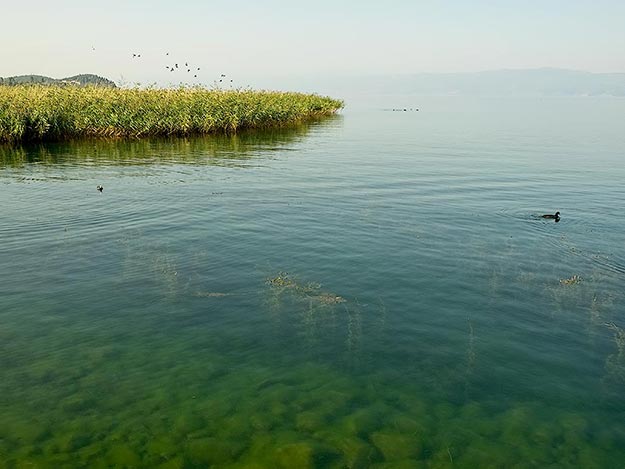
With no itinerary and a nose for sniffing out off-the-beaten-track destinations, I was only too happy to oblige. I made a reservation for three days at a local guest house and hopped on a bus. A week later, I was still there, trying to tear myself away in order to complete my tour of the Balkans before cold weather set in. I was too content. I worried that the first snow would have to fall before I finally decided to move on.
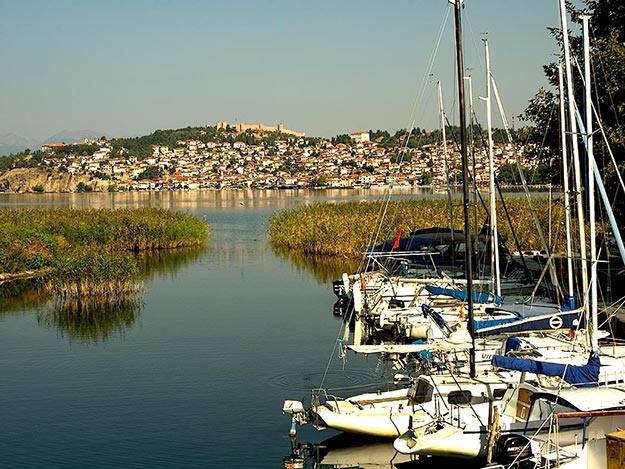
What held me so captive is hard to describe, but an overheard conversation in a local restaurant may say it best. The trio, all Macedonian by birth, had emigrated to Australia. Their discussion was in Macedonian, sprinkled with occasional English words. Midway through a sentence I clearly heard, “relaxed, relaxed, relaxed.” I looked up and all three of them were beaming.
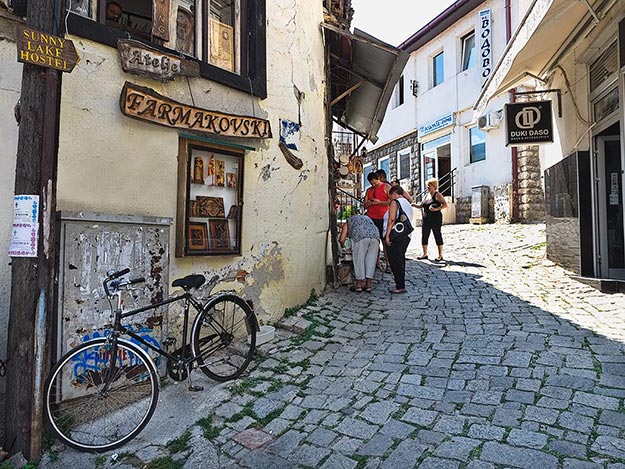
That, I realized, was the crux of what I felt – relaxed and happy. Even my sleep habits changed in Ohrid. Instead of working until 2 a.m. every morning and sleeping until nine, I was in bed by 10 p.m. and up early to walk the broad promenade along Lake Ohrid. I was joined by other early risers: men in the skimpiest of Speedo trunks taking a dip in the chilly lake; couples walking their dogs; and a duo that raced past the promenade in their built-for-speed fiberglass skull, oars dipping into the water in synchronicity with the song they bellowed.

Most mornings, I stopped at one of the myriad outdoor cafes that serve only drinks and desserts, enjoying a leisurely hour of espresso sipping. One day I climbed the stone-paved lanes to visit an old fortress that perches atop the cliff upon which the city of Ohrid is built. A stop at the ancient Roman Amphitheater and a stroll through the Upper Gate in the old city walls occupied me until early afternoon, when the heat forced me indoors for a nap.
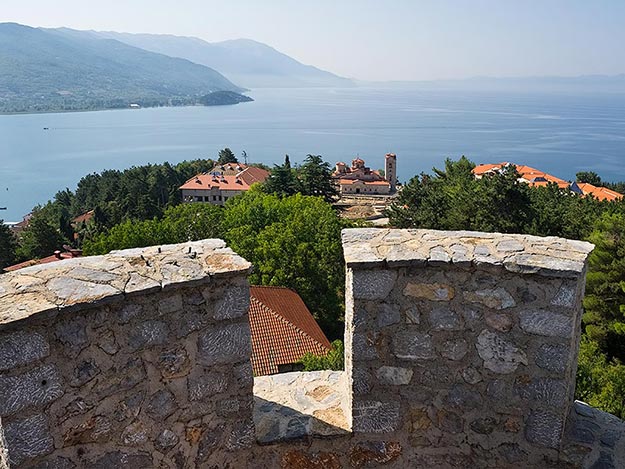
Taking a different route each day allowed me to poke my nose into dozens of the 365 churches that are said to allow worshipers to attend a different church every day of the year. St. Jovan, a particularly beautiful old church eluded me on the first attempt. A local woman told me to take the stairs up until I reached a dirt path through the forest and follow it to the church. The houses soon disappeared and I was in a pine forest, with views to the cobalt blue lake. Near the top of the cliff the path split in three directions. Eeny, meenie, miney, mo…I chose the one to the right, which led to the fortress. The following day, with the aid of a map, I discovered that a paved road led directly to St. Jovan.
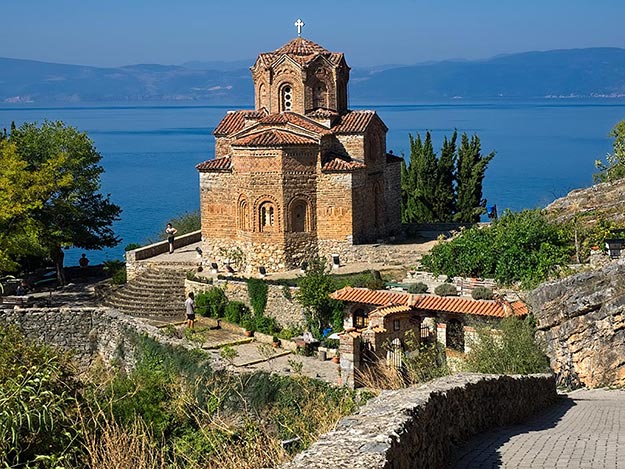
On days when my energy waned, I followed a wooden boardwalk around the base of the sea cliffs to a pocket beach and restaurant, where I plunked down with a cup of coffee. No one cared how long I dawdled; I saw men tarry over an espresso for more than two hours and I wasted no time availing myself of the privilege. The only problem I had was getting the bill and, in this case, when I finally requested it I was told “no charge.” A local man, with whom I had chatted for perhaps ten minutes, had paid for my coffee when he left.

This kindness of Macedonians was the rule rather than the exception. Days after I moved from my original guest house, the grandmother of the family spotted me in the main square and detoured to give me a big hug and kiss. The Macedonian-Australian trio sitting next to me in the restaurant left me with their phone numbers and addresses, insisting I must stay with them the next time I come to Australia.

After touring the House of Robevi National Museum and watching the owner of the National Workshop for Handmade Paper, Ljupho Paneski, demonstrate the centuries-old art of paper making, I decided it was time to explore further afield. The following morning I took a delightful 1.5 hour cruise to St. Naum on the southeastern corner of the lake, where springs on the River Crn Drim are the primary source of water for Lake Ohrid. Boats painted in rainbow colors were lined up near the mouth of the river, awaiting passengers. I paid my 300 Denars (about $6) and hopped aboard with two other tourists for the half hour round trip to the head of the springs.

The stream appeared to be no more than a few inches deep, so I was skeptical that our boat could actually reach the spring head, but soon after pushing off I learned that the shallowest portion of the stream is more than three feet deep. It only looks shallow because the water is so crystal clear. The moment we cleared the pier, I felt like I’d been transported into an Impressionist painting. Sunlight trickled through the trees, turning yellow reeds to gold; the river was a sparkling ribbon of turquoise and emerald. Loons pierced the quiet with their maniacal laughter. Ten feet beneath our boat, water bubbled up from vents like a giant pot of boiling water, though in this case, the water was ice cold.
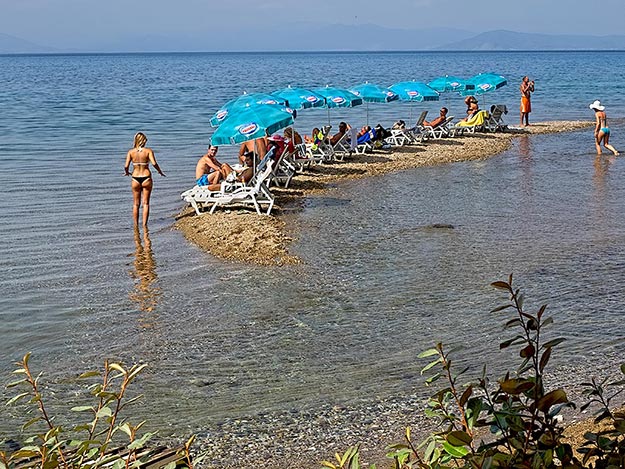
My trip would not have been complete without without a visit to the village of St. Naum, located near the southern point of the lake. The monastery of St. Naum, perched on a hilltop overlooking Lake Ohrid, was built at the beginning of the 10th century by an Orthodox monk of the same name. I arrived just as a wedding party was exiting. The bride, beautiful in a pearl-studded white gown, provided a stunning contrast to the priest, with his wild flowing gray beard and severe black cassock.
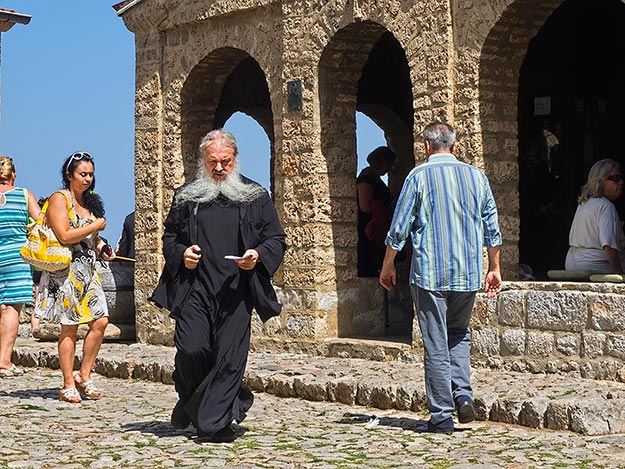
When the wedding party finally dispersed, I squeezed inside the tiny chapel, where people were lining up to pay their respects at a casket that holds the bones of Saint Naum. Macedonians believe that the saint’s heartbeat can still be heard by pressing their ear to the lid of the stone coffin. When it was my turn, I knelt on the floor and placed my ear on the satin coverlet that covered the crypt. The regular thump, thump, thump of a beating heart was was faint but clear.
As I returned to the harbor for the ride back to Ohrid, I mulled over whether my ability to hear the saint’s beating heart was a special blessing. I decided it was. I was truly blessed to have found Ohrid.

Very nice to read your musings on Lake Ohrid….I am going there in July and so looking forward! Thank you*
Hi Dollie: I hope you find it as beautiful as I did!
Wow. I am so going there. Was there sometimes strong wind for windsurfing and kitesurfing? Thanks!
Hello Ranjith. It’s an inland lake surrounded by mountains, so I donlt think there is any windsurfing or kitesurfing opportunities.
I enjoyed reading this – thank you
You’re very welcome, Laura. Thanks for your comment.